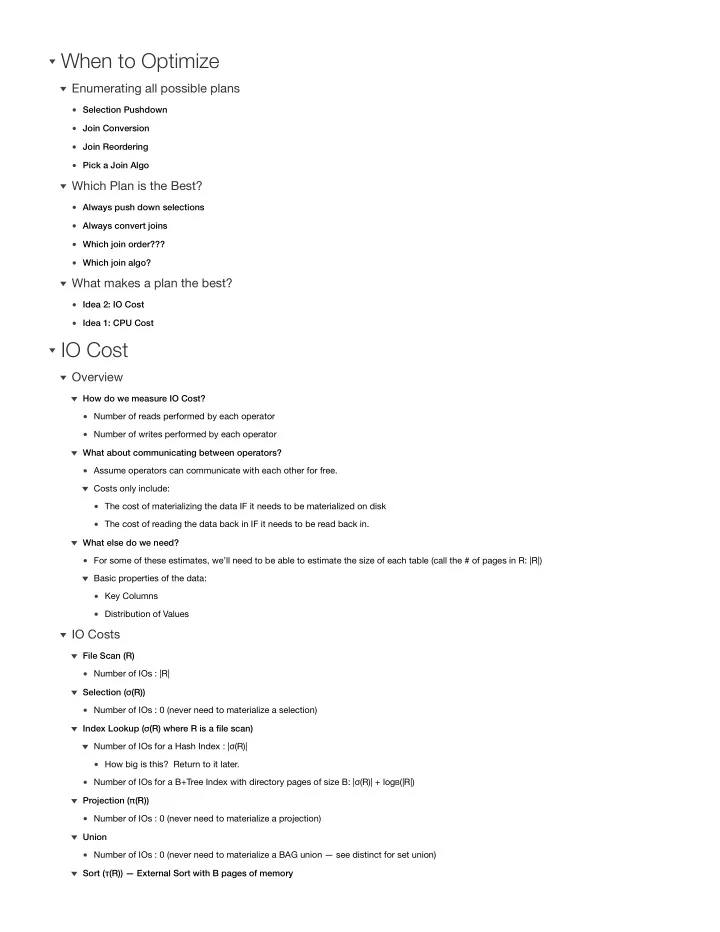

When to Optimize Enumerating all possible plans Selection Pushdown Join Conversion Join Reordering Pick a Join Algo Which Plan is the Best? Always push down selections Always convert joins Which join order??? Which join algo? What makes a plan the best? Idea 2: IO Cost Idea 1: CPU Cost IO Cost Overview How do we measure IO Cost? Number of reads performed by each operator Number of writes performed by each operator What about communicating between operators? Assume operators can communicate with each other for free. Costs only include: The cost of materializing the data IF it needs to be materialized on disk The cost of reading the data back in IF it needs to be read back in. What else do we need? For some of these estimates, we’ll need to be able to estimate the size of each table (call the # of pages in R: |R|) Basic properties of the data: Key Columns Distribution of Values IO Costs File Scan (R) Number of IOs : |R| Selection ( σ (R)) Number of IOs : 0 (never need to materialize a selection) Index Lookup ( σ (R) where R is a file scan) Number of IOs for a Hash Index : | σ (R)| How big is this? Return to it later. Number of IOs for a B+Tree Index with directory pages of size B: | σ (R)| + log B (|R|) Projection ( π (R)) Number of IOs : 0 (never need to materialize a projection) Union Number of IOs : 0 (never need to materialize a BAG union — see distinct for set union) Sort ( τ (R)) — External Sort with B pages of memory
Number of IOs : ~2 • log B (|R| / 2) Cross-Product (R x S) — BNLJ with B pages of memory for blocking R Number of IOs : |S| + (|R| / B) • (|S|) Need to write all of S to disk once: |S| pages Repeat (|R| / B) times… Read B pages of data from source operator R: Free Join the block with the materialized data in S, one tuple at a time: |S| Join (R ⋈ S) — 1-pass Hash/Tree Join Number of IOs: 0 (entirely in-memory) Join (R ⋈ S) — 2-pass Hash Join Number of IOs: 2 • (|R| + |S|) Write all |R| and |S| to disk, bucketizing: |R| + |S| Read in each bucket: |R| + |S| Join ( τ (R) ⋈ τ (S)) — Sort/Merge Join Number of IOs: 0 + cost of the τ (S) (Merge step is free) Join (R ⋈ R.A = S.A S) — Index Nested Loop Join (assuming index on S) Number of IOs: |R| • [ cost of one index lookup: σ [const] = S.A (S) ] Each inner loop is basically one Index Scan Aggregation ( ɣ (R)) — In-memory Number of IOs: 0 Aggregation ( ɣ (R)) — On-Disk, Hash-Based Number of IOs: 2|R| Write each bucket out, read each bucket in Aggregation ( ɣ ( τ (R)) — On-Disk, Sort-Based Number of IOs: 0 + cost of τ (R) Distinct ( δ (R))— Works EXACTLY like Aggregation Cardinality (Size) Estimation Most of the operators are straightforward π (R), τ (R) : |R| R U S : |R| + |S| R x S : |R| * |S| R ⋈ S : Identical to σ (R x S)… Some are hard σ (R) ɣ (R) & δ (R) Selection : Compute Selectivity (or % tuples passed through) Generic (Default) Heuristic: Selectivity = 0.5 Works … mostly well 70% of the time. Very brittle and liable to break things Be wary : DBMSes actually do this! R.A = [Const] If R.A is a Key, then precisely 1 tuple passes through… given Idea : Collect stats: # of distinct values Selectivity = 1 / # of distinct values of R.A
Works well… but only for discrete data (Strings, Ints, Dates) Also gives you “Key” for free Also works for R.A in [List] R.A < [Const] (also works for others) Idea : Collect stats: Min/Max, and assume a uniform distribution of values Selectivity = ([Const] - Min) / (Max - Min) Works for continuous data (Floats) R.A = R.B (the Equijoin condition) Idea 1 : Assume no correlation Becomes identical to either R.A = const or R.B = const For each row, you’re testing whether R.B = Some specific, somewhat arbitrary value Both are an upper bound on the selectivity, so take whichever reduction gives you the lower value C1 AND C2 Assuming no correlation between C1 and C2: Selectivity(C1) • Selectivity(C2) Going more fancy: Histograms (See attached)
Recommend
More recommend